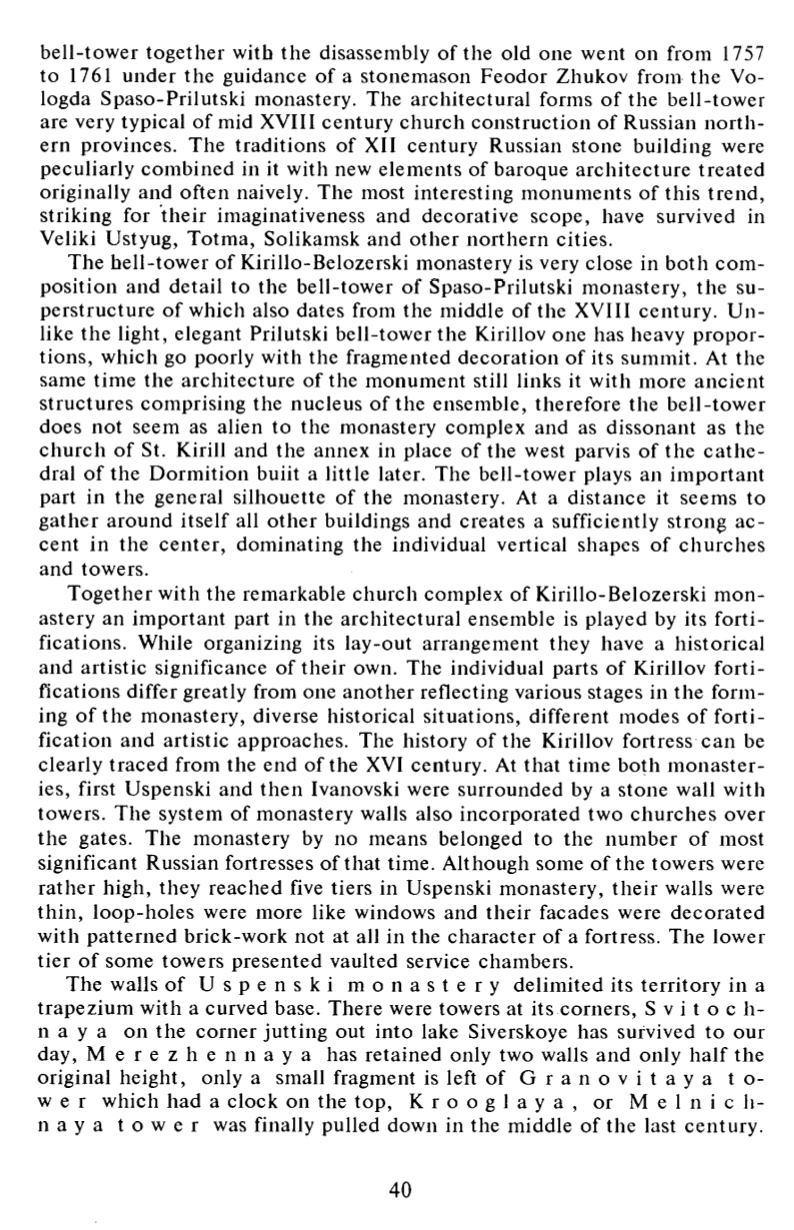

bell-tower together with the disassembly of the old one went on from 1757
to 1761 under the guidance o f a stonemason Feodor Zhukov from the Vo
logda Spaso-Prilutski monastery. The architectural forms o f the bell-tower
are very typical of mid XVIII century church construction of Russian n o r th
ern provinces. The traditions of XII century Russian stone building were
peculiarly combined in it with new elements of baroque arch itecture treated
originally and often naively. The most interesting monumen ts of this trend,
striking for their imaginativeness and decorative scope, have survived in
Veliki Ustyug, Totma, Solikamsk and o ther no rthe rn cities.
The hell-tower of Kirillo-Belozerski monastery is very close in bo th c om
position and detail to the bell-tower of Spaso-Prilutski monastery, the su
perstructure o f which also dates from the middle of the XVIII century. U n
like the light, elegant Prilutski bell-tower the Kirillov one has heavy p ropo r
tions, which go poorly with the fragmented decoration o f its summit. At the
same time the architecture of the monumen t still links it with more ancien t
structures comprising the nucleus o f the ensemble, therefore the bell-tower
does no t seem as alien to the monastery complex and as dissonant as the
chu rch o f St. Kirill and the annex in place of the west parvis o f the c a t h e
dral o f the Do rmition buiit a little later. The bell-tower plays an importan t
part in the general silhouette of the monastery. At a distance it seems to
gather around itself all o ther buildings and creates a sufficiently strong a c
cent in the cen te r, dominating the individual vertical shapes o f churches
and towers.
Together with the remarkable church complex of Kirillo-Belozerski m o n
astery an importan t part in the architectural ensemble is played by its fo rti
fications. While organizing its lay-out arrangement they have a historical
and artistic significance of their own. The individual parts of Kirillov fo rti
fications differ greatly from one another reflecting various stages in the fo rm
ing o f the monastery, diverse historical situations, different modes o f fo rti
fication and artistic approaches. The history of the Kirillov fortress can be
clearly traced from the end of the XVI century. At that time both mon a s te r
ies, first Uspenski and then Ivanovski were surrounded by a stone wall with
towers. The system of monastery walls also incorporated two chu rches over
the gates. The monastery by no means belonged to the number o f most
significant Russian fortresses of that time. Although some o f the towers were
rathe r high, they reached five tiers in Uspenski monastery, their walls were
th in , loop-ho les were more like windows and their facades were deco rated
with pa tte rned brick-work not at all in the character of a fortress. The lower
tier o f some towers presented vaulted service chambers.
The walls o f U s p e n s k i m o n a s t e r y delimited its territory in a
trapezium with a curved base. There were towers at its corners, S v i t о с h -
n a у a on the corner ju tting out into lake Siverskoye has survived to our
day, M e r e z h e n n a y a has retained only two walls and only ha lf the
original height, only a small fragment is left of G r a n o v i t a y a t o
w e r which had a clock on the top, К г о о g 1 a у a , or M e 1 n i с h-
n a y a t o w e r was finally pulled down in the middle of the last century.
40















